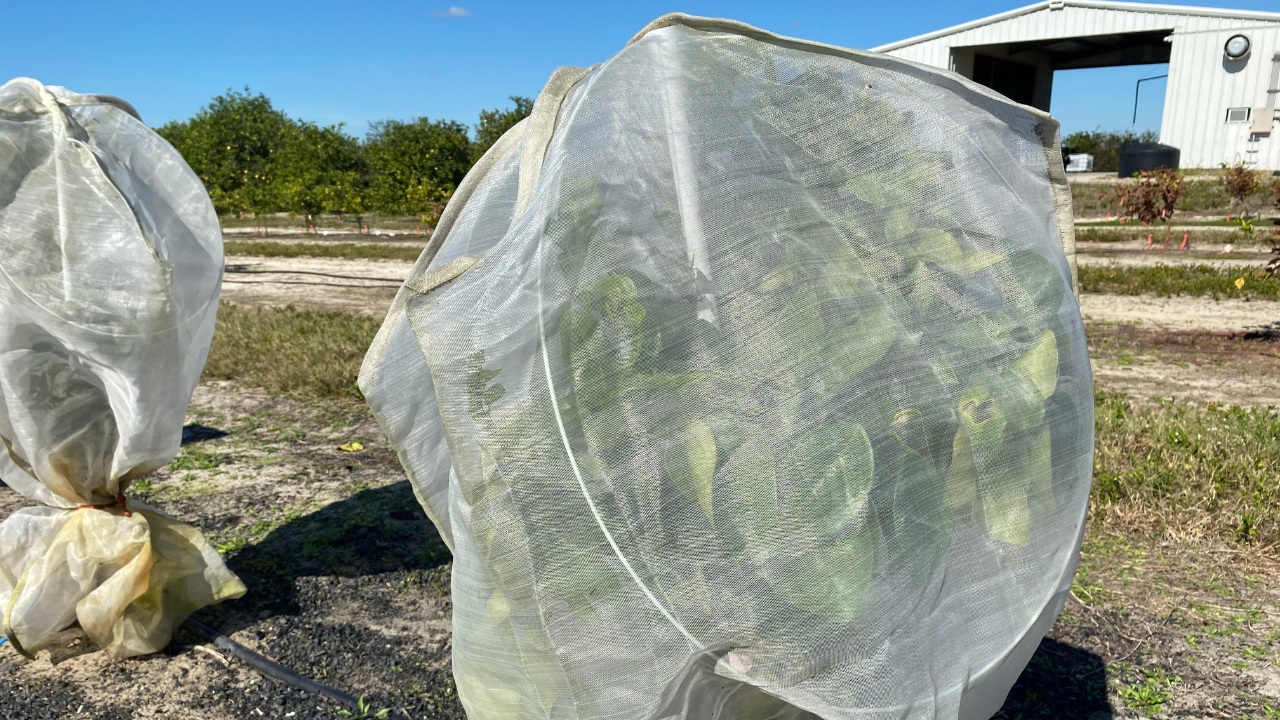LAKE ALFRED, Fla. — As she walks down almost endless rows of orange trees, Dr. Lauren Diepenbrock is in her happy place.
“I love it,” she said with a smile. “It’s the best job I could ever ask for.”
But Wednesday afternoon, what brought her to one of the experimental citrus groves at the University of Florida Citrus Research and Education Center in Polk County was a problem that’s become a crisis to Florida’s citrus industry. She was there to check on potentially dying patients — and the treatments being administered to them.

Many citrus trees have been infected with a disease called citrus greening, and it’s one Diepenbrock and other researchers are trying to cure.
The disease is caused when a tiny flying bug — called the Asian citrus psyllid — injects orange trees with a bacterium. According to Diepenbrock, the ailment can cause orange trees to die slow deaths. While some are more tolerant, other trees’ fruits become fewer and lopsided.
“Oh, it’s all over the place,” said Diepenbrock, as she examined a warped, blotchy leaf that displayed the telltale signs of citrus greening. “I mean, pretty much every grove has it. Almost every tree has it. It’s just a question of how far along it is, and what we can do to keep those trees healthy.”

Citrus greening is threatening citrus production around the world, and Florida’s $8.6 billion citrus industry is no exception.
A United States Department of Agriculture (USDA) Oct. 2021 forecast predicts Florida’s current citrus season will under-perform when compared to last year. According to the USDA, the production of oranges might decline 11% to 47 million boxes.
Diepenbrock says citrus greening is part of the reason some growers are becoming increasingly worried, as the price of production goes up and yields go down. It’s a predicament that could increase the prices of fresh citrus and orange juice.
“Well, if you like citrus, I mean, we have to solve this issue because, one, the prices for production are going up, so both fresh fruit and juice production — it’s more expensive now than when I was a kid,” she said. “I grew up down here, and it was cheap to have. We always had citrus when it was in season, and now, it’s not so cheap. You go to the grocery store, and you really have to think, do I want to spend the money on this beautiful fruit? It’s expensive.”
But, there is optimism at the UF Citrus Research and Education Center. UF Institute of Food and Agricultural Sciences (IFAS) researchers like Diepenbrock, Dr. Michael Rogers, and others, are collaborating on a myriad of research projects to mitigate and prevent citrus greening.
“We’re committed to making sure that we have a solution to keep orange juice on the shore shelves and fresh fruit in the market,” said Rogers.

Weeks ago, the center was awarded millions in new grants to UF/IFAS to strengthen its research. The USDA’s National Institute of Food and Agriculture (NIFA) Emergency Citrus Disease Research and Extension Program awarded over $2.2 million. UF/IFAS researchers are also serving in leadership roles in two other multi-million-dollar grants, which brings the total to more than $3.5 in federal funding for UF’s research.
“Now, where we are — we’re looking at ways to manage the disease once the trees are already sick,” explained Rogers. “How can we keep the trees that already have this disease alive and productive?”
He said the research will also focus on two other key areas: stopping the spread of citrus greening at its source by altering bacteria transmission from the fly-like parasite and developing tree varieties that are resistant to the disease.
For a more detailed explanation of the projects, click here.
Some of the important experiments were already in progress in the research grove Diepenbrock meticulously roamed on Wednesday.
There, some young Valencia orange trees are shrouded in netting. Others are coated in a kaolin — a clay-like mineral — that’s dyed red. Both techniques are being studied as potential methods of keeping the parasites off citrus trees.


Ever so often, research assistants will use handheld microscopes to carefully count the tiny parasites and their larvae on the experimental trees as a way to see if the techniques are working.
“So we’re seeing an impact, and it’s just a question of how great is that impact to make it worthwhile to the bottom line,” said Diepenbrock.
In a separate portion of the grove, some of the trees now sprout from soil coated by a shiny tarp-like mat that researchers call reflective mulch.
“It’s very uncomfortable for us to stand on to count bugs, and so maybe that reflection helps deter the pests from finding the actual tree to land on,” Diepenbrock explained.
Ultimately, researchers like Diepenbrock believe they will make significant breakthroughs, which is what keeps her motivated.
“The work’s rewarding because you get to actually see your impacts on growers, and you get to help people,” she said. “I mean, how cool is it that what I do helps produce food that goes on your table? I think that’s really neat.”
Nearby, under a sparkling sun and deep blue sky, perfect orange orbs dotted a Sugar Bell citrus tree. Diepenbrock glanced up at the perfect specimens, which are just coming into season.
“We have to worry about the longevity of this crop,” she said. “This is an iconic crop for the State of Florida, so we want to make sure that it is healthy, and we want to keep it around for a long time, and we want to keep enjoying it.”





